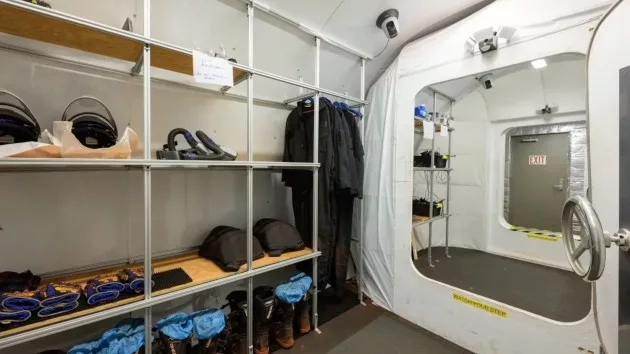(NEW YORK) — For over a year, four crew members participating in NASA’s Mars Dune Alpha simulated experience communicated, ate, slept and researched as if they were stationed over 200 million miles away on the Red Planet.
The mission, which marked the first completed installment of three planned programs from NASA’s Crew Health and Performance Exploration Analog (CHAPEA), lasted 378 days and began on June 25, 2023.
Kelly Haston, Anca Selariu, Ross Brockwell and Nathan Jones were greeted by a round of applause over the weekend as they emerged from the 1,700-square-foot, 3D-printed habitat at the Johnson Space Center in Houston, Texas.
“Hello. It’s actually just so wonderful to be able to say hello to you all,” CHAPEA commander Haston said during a press conference as she emerged from the habitat.
The program was set up to research how crew members would respond to the conditions and constraints of a year-long mission, with NASA saying they could send astronauts to Mars as soon as the 2030s.
“Mars is our goal,” Stephen Koerner, deputy director of NASA’s Johnson Space Center, said during the press conference Saturday.
“As global interests and capabilities in space exploration continue to expand, America is poised to lead,” he said, adding, “The completion of the CHAPEA-1 mission is an important step in this goal.”
Simulated spacewalks, robotic operations, habitat maintenance, exercise and crop growth were among the crew members’ daily activities during the mission.
The CHAPEA crew simulated a Mars-realistic communication delay of up to 22 minutes one way, according to NASA, which includes messages with mission control and communication with the crew’s friends and family outside of the mission.
There were no fresh food deliveries, so the team members were limited to prepackaged, shelf-stable foods and the ability to grow some crops during the mission.
The crop growth system inside the CHAPEA habitat is similar to systems used for indoor home gardening and can support the growth of leafy crops, herbs and small fruits, according to NASA.
“I’m grateful for the chance to live the idea that we must utilize resources no faster than they can be replenished and produce waste no faster than they can be processed back into resources,” crew member Brockwell said during the press conference.
Mars Dune Alpha offered four separate sleeping quarters for crew members, with a 1,700-square-foot total interior, according to NASA. The habitat included a bathroom and shower area, a kitchen and a living room with a table and furniture, and designated areas for fitness and laundry.
Suzanne Bell, lead for NASA’s Behavioral Health and Performance Laboratory at Johnson Space Center, spoke to ABC News in February when the agency was recruiting for its second mission.
“We mimic what we expect for a Mars habitat surface mission,” Bell said. “We collect all sorts of data so we can learn how humans can survive and thrive in that circumstance.”
The next CHAPEA mission is slated for spring 2025; the third is expected to begin in 2026.
Bell said the three missions are designed to eliminate the “anomaly of a particular crew or individuals.”
“We’re seeing how we can best support people in the circumstances for their human health. We’re starting to see trends that we could interpret to best support people of the future,” Bell explained.
To qualify for the program, volunteers must be healthy, nonsmoking U.S. citizens or permanent residents between the ages of 30 and 55 and proficient in English.
Crew members must have a master’s degree with STEM qualifications and experience in the field or a minimum of 1,000 hours piloting an aircraft or the requisite military experience.
“I’ve been asked many times: Why the obsession with Mars? Why go to Mars?” crew member Selariu said after concluding the mission. “Because it’s possible,” Selariu continued, adding, “Because space can unite and bring out the best in us. Because it’s one defining step that Earthlings will take to light the way into the next centuries.”
Copyright © 2024, ABC Audio. All rights reserved.

